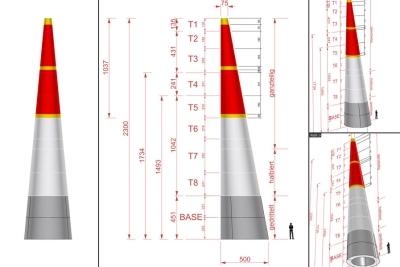Mon, Jan 06, 2014
Says New Gates Are Safest, Most Stable Pylons Yet
Red Bull Air Race prepares to return in 2014 as the fastest motorsport series in the world. And alongside next season's new racing rules and regulations, fans will see the return of the world-renowned pylon Air Gates. Since their last public outing in 2010, the teams at Red Bull Air Race have been working hard to engineer the safest, most stable pylons yet.

For the 2014 season, the race pylons will be bigger and better than ever, retaining their iconic cone shape, but with marked safety improvements. "The most obvious change for the new pylons is their overall height ... over 82 feet ... they will stand 16 feet taller than those used in the 2010 Red Bull Air Race World Championship.
The one-sided, asymmetrical pylon cones will once again have a straight inner edge with an inclined outer edge, creating a perfect rectangular flight window between the Air Gates. But crucially, the change in pylon height has elevated the flight window by 16 feet, from about 33 feet to just under 50 feet from the ground– improving the overall flying safety of the race track.
Red Bull Air Race pylons must serve two fundamental purposes - rip apart instantly on contact without impacting the pilot or plane, but also remain stationary in all weather conditions. Since the first races in 2003, 30 different materials and fabrics have been assessed for their suitability as Red Bull Air Race pylons. This process has involved rigorous assessments, from simple 'pylon hit' simulations using cars with mounted wings, to highly sophisticated computer calculations.
A closer look at the pylons reveals that each cone structure is manufactured using different materials. The nine segments that make up each pylon are all defined by their maximum strength allowed. With the change in height, the shape of the new pylons had to be adapted, and the materials used to make the Air Gates re-evaluated. The result is that the pylons now have a base diameter of 5m, and a top diameter of just 0.75m. The top part of each pylon is made from spinnaker fabrics – lightweight, flexible materials used to make boat sails. The spinnaker fabrics used in the new pylon tops weigh around 40% less than standard printer paper.
Red Bull says that the new flight windows will make this year's series the safest Red Bull Air Race World Championship yet.
More News
Aviation Governance Secured...At Least For a While The National Business Aviation Association similarly applauded the passage of the FAA's recent reauthorization, contentedly recou>[...]
Emphasis On Growing The Future of Aviation Through Concentration on 'AFFORDABLE FLYERS' It's been a number of years since the Latest Edition of Jim Campbell's HUGE SportPlane Resou>[...]
Amazilia Aerospace GmbH, Develops Digital Flight Control, Flight Guidance And Vehicle Management Systems Textron eAviation has acquired substantially all the assets of Amazilia Aer>[...]
Honeywell's Primus Brings New Tools and Niceties for Hawker Operators Hawker 4000 business jet operators have a new installation on the table, now that the FAA has granted an STC f>[...]
Company Celebrates Niche-but-Important Advancement in Industry Standards Echodyne has announced full integration of its proprietary 'EchoFlight' radar into the e American Aerospace>[...]
 Bolen Gives Congress a Rare Thumbs-Up
Bolen Gives Congress a Rare Thumbs-Up The SportPlane Resource Guide RETURNS!!!!
The SportPlane Resource Guide RETURNS!!!! Buying Sprees Continue: Textron eAviation Takes On Amazilia Aerospace
Buying Sprees Continue: Textron eAviation Takes On Amazilia Aerospace Hawker 4000 Bizjets Gain Nav System, Data Link STC
Hawker 4000 Bizjets Gain Nav System, Data Link STC Echodyne Gets BVLOS Waiver for AiRanger Aircraft
Echodyne Gets BVLOS Waiver for AiRanger Aircraft



